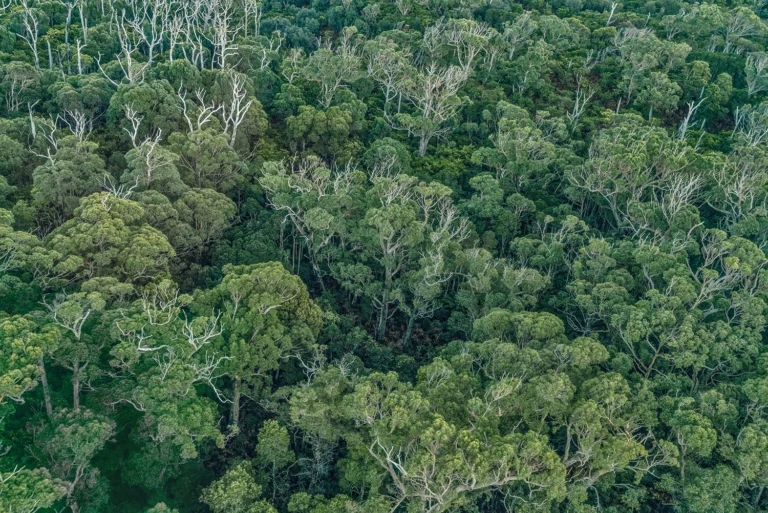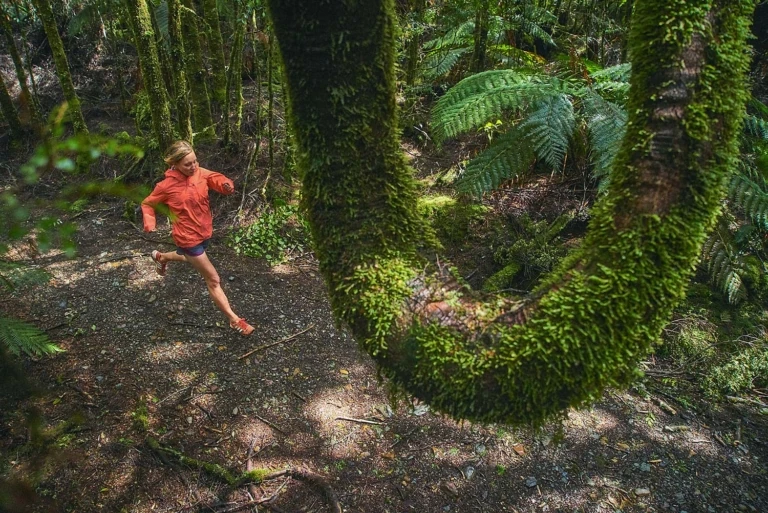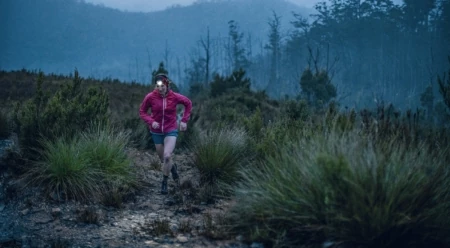The Way There: Why We Create and Seek Out Trails
It starts with the focal beam of a headlamp. Sunrise is more than an hour away and it’s pouring rain. Hands tucked into the sleeves of a jacket, and the pace already quick through the sharp Tasmanian buttongrass—trying to stay warm. There is an urgency to understand this threatened place, to know takayna / Tarkine as intimately as possible while its future remains in question—to know what the absence would feel like if it disappeared.
Australia is a place that compels long-distance travel, and the species that live there have evolved to do it well. Kangaroos have been recorded traveling 200 miles in under 10 hours; they store fat in their tails to be used when resources are scarce. Tasmanian devils can cover over 18 miles in a single night in search of food.
This perpetual movement of species creates a system of trails that is both physically and historically recorded on earth’s landscape. Scientists in Newfoundland are studying the fossil records of 565 million-year-old animal trails, which are thought to be evidence of the earliest form of locomotion.
Humans, too, write their patterns on the landscape.
The Aboriginal Australians believe that the world was sung into existence and thus holds a system of paths across the land, called songlines, which are learned through the repetition of words. By repeating these songs in the appropriate order, it is possible to traverse vast distances across the continent without ever having known the way. As author Robert Moor wrote in his book On Trails, “The land grows to contain not just resources, but stories.”
There are songlines across the takayna / Tarkine and an ancient history that resonates across the landscape. On this trail, it’s felt and learned with every step.

takayna / Tarkine contains Australia’s largest remaining single tract of temperate rainforest. Photo: Mikey Schaefer
What is this impulse to cover great distances?
Biologists will tell you that the individual decision to move is based primarily on immediate needs—food, escape, sex, learning, not necessarily in that order. From the caribou to the Arctic tern, some species aspire to go farther, whether it’s to find a mate or simply see what is beyond the next mountain range. Why do certain species move in familiar patterns?
The more familiar the pattern, the less energy is expended in pursuit of these resources. And the ability to move only increases the odds of achievement. According to writer Bruce Chatwin, a salmon knows the taste of its ancestral river, and birds that fly at night can determine the contours of the ground below by bouncing their calls down to earth and catching the echo on the way back. This familiarity is the connection that gets passed on through generations.
The Aboriginal Australians are not alone in their intricate relationship to landscape and movement. The Cherokee once chose guides from members of their tribe who were tasked with finding the best paths through the landscape. The Blackfeet made sacred journeys from Canada to Mexico along “the backbone of the world,” or the modern-day Continental Divide. Tendai Buddhist monks still run 1,000 marathons in 1,000 days around Mount Hiei in order to achieve enlightenment. These are the journeys that extend beyond basic need to a spiritual and metaphorical connection with movement and with land.

Meaghen Brown pilots her way through the takayna / Tarkine wilderness in Tasmania. Photo: Mikey Schaefer
It’s been hours now. The rain has stopped, and the early spring sun is warm on exposed skin. A few land leeches cling on, picked up somewhere along the trail. The trails through the takayna / Tarkine are still at risk. But the suspended reality of being here extends well beyond the pause for breath and the return home.
Movement through a landscape is the best way to learn a place. And knowing that landscape, falling in love with it, only intensifies the desire to protect it.
This story first appeared in the Patagonia 2018 Summer catalog.
takayna
takayna / Tarkine in northwestern Tasmania is home to one of the last undisturbed tracts of ancient rainforest in the world, and one of the highest concentrations of Aboriginal archaeology in the southern hemisphere. Yet this place is currently threatened by logging and mining. Our new film takayna, weaves together the narratives of activists, a trail running doctor and the Aboriginal community to unpack the complexities of modern conservation and challenge us to consider the importance of our last truly wild places.
Patagonia is partnering with the Bob Brown Foundation and the Aboriginal community and calling for the Tasmanian Government to nominate the Tarkine for World Heritage protection.

